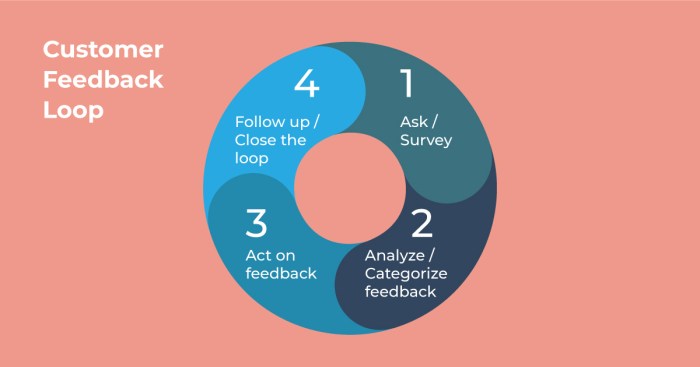Customer Feedback Loops play a vital role in the success of businesses, offering insights that drive product improvement and customer satisfaction. Dive into the world of feedback loops and discover their significance in today’s competitive market.
Importance of Customer Feedback Loops
Customer feedback loops are like the secret sauce for businesses, helping them understand what customers really think about their products or services. This valuable input allows companies to make informed decisions and improvements to meet customer needs and stay ahead of the competition.
Enhancing Product Development
Customer feedback loops can provide insights into what customers love or dislike about a product. By analyzing this feedback, businesses can identify areas for improvement, develop new features, or even create entirely new products that better align with customer preferences. For example, a software company might receive feedback that users find a particular feature confusing. By addressing this issue based on customer input, the company can enhance the overall user experience and increase customer satisfaction.
Building Customer Satisfaction and Loyalty
Listening to customer feedback shows that a business values its customers’ opinions and is committed to providing the best possible experience. When customers feel heard and see their feedback implemented, it can lead to increased satisfaction and loyalty. For instance, a restaurant that takes feedback on its menu seriously and makes adjustments based on customer preferences is more likely to retain customers and attract new ones through positive word-of-mouth.
Types of Customer Feedback Loops

Customer feedback loops come in various types that businesses utilize to gather insights and improve their products or services. One crucial distinction is between proactive and reactive feedback loops, each serving a unique purpose in enhancing customer experience.
Proactive Feedback Loops
Proactive feedback loops involve seeking feedback from customers before any issues arise. This can be done through surveys, suggestion boxes, or beta testing new features. By actively reaching out to customers, businesses can anticipate needs and make improvements preemptively.
Reactive Feedback Loops
Reactive feedback loops, on the other hand, respond to feedback given by customers after an experience with a product or service. This feedback can come from reviews, complaints, or direct communication with customer support. It allows businesses to address specific concerns and rectify issues to enhance customer satisfaction.
Real-Time Feedback Loops
In today’s fast-paced business environment, real-time feedback loops have become increasingly important. These feedback mechanisms provide immediate insights into customer preferences and experiences, allowing businesses to make quick adjustments and improvements. Technologies like live chat, social media monitoring, and feedback forms enable businesses to gather real-time feedback and respond promptly to customer needs.
Implementing Effective Feedback Collection Methods

Effective feedback collection is crucial for businesses to understand customer needs and improve their products or services. By utilizing various strategies and tools, companies can gather valuable insights to drive growth and innovation.
Utilizing Multiple Channels for Feedback Collection, Customer Feedback Loops
It is essential to gather feedback through multiple channels to reach a diverse range of customers and capture different perspectives. By utilizing various channels such as email surveys, social media polls, website feedback forms, and in-person interviews, businesses can collect a comprehensive set of data to inform their decision-making process.
- Send out targeted email surveys to gather feedback from customers who have recently interacted with your product or service.
- Utilize social media platforms to create polls and engage with customers in real-time to gather instant feedback.
- Embed feedback forms on your website to capture feedback from visitors and track user behavior to identify pain points.
- Conduct in-person interviews or focus groups to gather qualitative feedback and gain deeper insights into customer preferences and experiences.
Tools and Technologies for Streamlining Feedback Collection
There are various tools and technologies available to streamline the feedback collection process and make it more efficient for businesses.
- Customer feedback management platforms like SurveyMonkey, Typeform, or Qualtrics allow businesses to create and distribute surveys easily and analyze the results in real-time.
- Feedback widgets integrated into websites can enable customers to provide feedback directly on specific pages, making it convenient for them to share their thoughts.
- Social media listening tools like Hootsuite or Sprout Social can help businesses monitor conversations and sentiment around their brand, enabling them to proactively address customer feedback.
- CRM systems like Salesforce or HubSpot can centralize customer feedback data and integrate it with other customer information to provide a holistic view of customer sentiment and preferences.
Analyzing and Utilizing Customer Feedback
When it comes to analyzing and utilizing customer feedback, businesses need to dive deep into the data to extract valuable insights that can drive decision-making and improvements. Here’s how businesses can make the most out of customer feedback data:
Interpreting Customer Feedback Data
- Identifying common themes or issues raised by customers.
- Segmenting feedback based on demographics, purchasing behavior, or other relevant criteria.
- Quantifying the impact of each feedback point on customer satisfaction and loyalty.
Before making any changes based on customer feedback, businesses must thoroughly analyze the data to understand the underlying patterns and trends. This involves:
Data Analytics for Actionable Insights
- Identify correlations between feedback and key business metrics.
- Utilize sentiment analysis to gauge customer emotions and perceptions.
- Predict future trends and behaviors based on historical feedback patterns.
Data analytics plays a crucial role in transforming raw feedback data into actionable insights. By leveraging analytics tools and techniques, businesses can:
Implementing Changes Based on Feedback Analysis
- Introducing new product features based on customer requests and suggestions.
- Revamping customer service processes to address common pain points highlighted in feedback.
- Adjusting marketing strategies to better resonate with customer preferences and feedback.
Successful businesses use customer feedback analysis to drive meaningful changes and improvements. Some examples include:
Closing the Feedback Loop: Customer Feedback Loops
Closing the feedback loop with customers is a crucial step in the customer feedback process. It involves taking the feedback received from customers, acknowledging it, and implementing changes or improvements based on that feedback. By effectively closing the loop, companies can show their customers that their opinions are valued and that their feedback is being taken seriously.
Acknowledging Customer Feedback
- Respond promptly to customer feedback, whether it is positive or negative.
- Thank customers for taking the time to provide feedback.
- Acknowledge specific points raised by customers to show that their feedback is being heard.
Implementing Changes Based on Feedback
- Analyze customer feedback to identify common themes or issues.
- Develop an action plan to address the feedback received.
- Communicate with customers about the changes being made based on their feedback.
Examples of Effective Feedback Loop Closure
- Amazon: Amazon collects feedback from customers on product reviews and uses that feedback to improve product listings and customer experience.
- Zappos: Zappos has a dedicated customer service team that follows up with customers who provide feedback, ensuring that their concerns are addressed and resolved.
- Apple: Apple regularly updates its products based on customer feedback, incorporating new features and improvements suggested by users.





